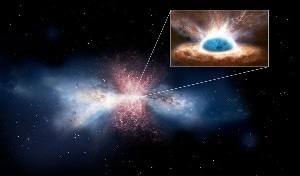Jan 31 2018
The presence of huge numbers of molecules in winds powered by supermassive black holes at the centers of galaxies has indeed puzzled astronomers since they were revealed more than a decade ago. Molecules are capable of tracing the coldest parts of space and black holes are considered to be the most energetic phenomena in the universe, thus finding molecules in black hole winds was similar to discovering ice in a furnace.
 Image credit: Northwestern University
Image credit: Northwestern University
Astronomers interrogated how it could be possible for anything to survive the heat of the energetic outflows, but a new theory developed by researchers in Northwestern University’s Center for Interdisciplinary Research and Exploration in Astrophysics (CIERA) forecasts that these molecules are not survivors at all, but brand-new molecules, originating in the winds with exceptional properties that allow them to adapt to and then thrive in the hostile environment.
The theory, featured in the Monthly Notices of the Royal Astronomical Society, is the work of Lindheimer post-doctoral fellow Alexander Richings, who created the computer code that, for the very first time, succeeded in modeling the in-depth chemical processes that takes place in interstellar gas enhanced by radiation emitted during the growth of supermassive black holes. Claude-André Faucher-Giguère, who studies the formation of galaxies and evolution as an assistant professor in Northwestern’s Weinberg College of Arts and Sciences, is a co-author.
When a black hole wind sweeps up gas from its host galaxy, the gas is heated to high temperatures, which destroy any existing molecules. By modeling the molecular chemistry in computer simulations of black hole winds, we found that this swept-up gas can subsequently cool and form new molecules.
Alexander Richings, Lead Author
This theory answers questions raised by earlier observations made with a number of cutting-edge astronomical observatories including the Atacama Large Millimeter Array, a powerful radio telescope based at Chile, and the Herschel Space Observatory.
In 2015, astronomers proved the presence of energetic outflows from supermassive black holes discovered at the center of most galaxies. These outflows kill everything that comes in their path, banishing the food – or molecules – that fuel star formation. These winds are also believed to be responsible for the presence of “red and dead” elliptical galaxies, in which no new stars can develop.
In 2017, astronomers observed quickly moving new stars developing in the winds – a phenomenon they assumed would be impossible with the existing harsh conditions in black hole-powered outflows.
New stars develop from molecular gas, hence Richings and Faucher-Giguère’s new theory of molecule formation enables explaining the development of new stars in winds. It upholds earlier predictions that black hole winds abolish molecules upon the first collision but also forecasts that new molecules – including carbon monoxide, hydrogen and water – can develop in the winds themselves.
This is the first time that the molecule formation process has been simulated in full detail, and in our view, it is a very compelling explanation for the observation that molecules are ubiquitous in supermassive black hole winds, which has been one of the major outstanding problems in the field.
Claude-André Faucher-Giguère, Co-Author
Richings and Faucher-Giguère foresee that the new molecules developed in the winds are brighter and warmer in infrared radiation when compared to pre-existing molecules. That theory will be tested when NASA launches the James Webb Space Telescope in spring 2019. If the theory is correct, the telescope will be capable of mapping black hole outflows in a detailed manner with the help of infrared radiation.